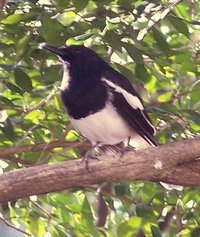Oriental Magpie Robin
|
|
| Oriental Magpie Robin | ||||||||||||||
|---|---|---|---|---|---|---|---|---|---|---|---|---|---|---|
 | ||||||||||||||
| Scientific classification | ||||||||||||||
| ||||||||||||||
| Binomial name | ||||||||||||||
| Copsychus saularis (Linnaeus, 1758) |
The Oriental Magpie Robin, Copsychus saularis, is a small passerine bird that was formerly classed as a member of the thrush family Turdidae, but is now more generally considered to be an Old World flycatcher, family Muscicapidae.
This magpie-robin is an insectivorous species which is a resident breeder in tropical southern Asia from Pakistan, India and Sri Lanka east to Indonesia, south China and the Philippines.
The Oriental Magpie Robin is found in open woodland, cultivated areas and around human habitation. It nests in a hole, often in a wall, laying 3-6 eggs which are incubated by both sexes.
This species is 19cm long, including the long cocked tail. It is similar in shape to the smaller European Robin, but is longer-tailed.
Magpie_Robin_Female.jpg
The male has black upperparts, head and throat apart from a white shoulder patch. The underparts and the sides of the long tail are white. Females are grey above and greyish white. Young birds have scaly brown upperparts and head.
The Oriental Magpie Robin is a common and tame bird. It is terrestrial, hopping along the ground with cocked tail. The male sings a few melodic notes during courtship.
The Oriental Magpie Robin, locally called the Dhayal, was once common in the Indian songbird trade. When a specimen reached Linnaeus it was apparently labelled Dial and thinking this had something to do with a sun-dial, he gave it the scientific name of 'solaris' ('saularis' in error).
Reference
- Birds of India by Grimmett, Inskipp and Inskipp, ISBN 0-691-04910-6
